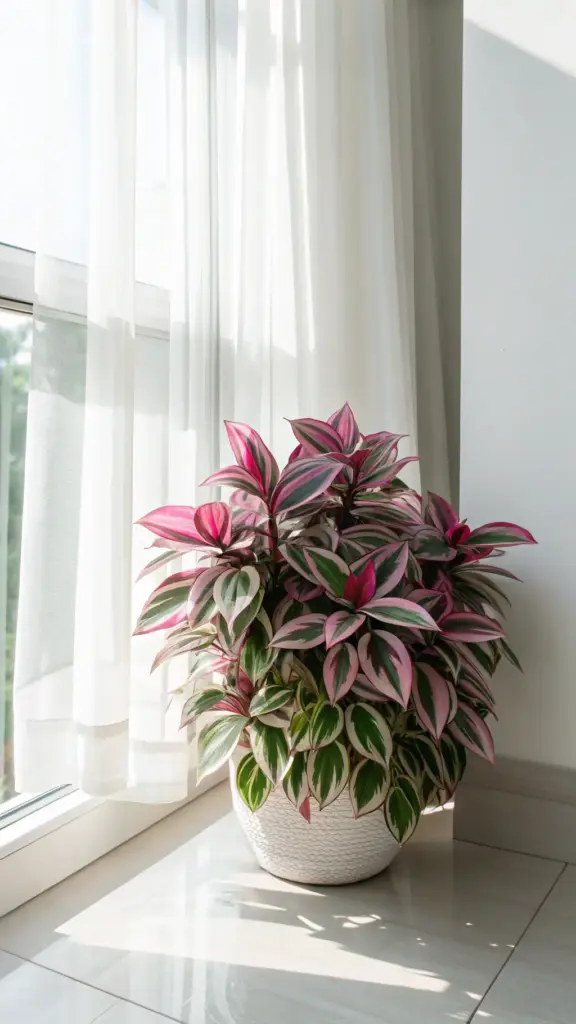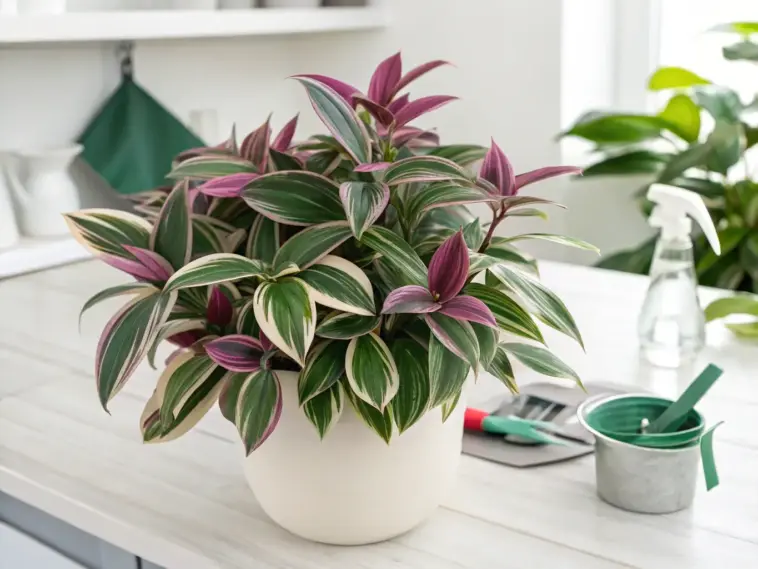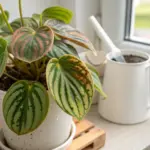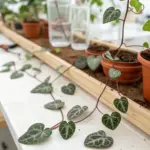Did you know that 73% of millennial women consider their houseplants as important as their home decor? If you’re one of those plant parents who fell head-over-heels for the stunning Tradescantia Nanouk, you’re not alone!
This gorgeous trailing beauty has taken social media by storm with its dreamy pink, purple, and silver variegation. But here’s the thing – getting those picture-perfect colors isn’t always as easy as it looks on Instagram.
I’ve been there too, watching my Nanouk lose its vibrant hues and wondering what I was doing wrong. After years of trial and error (and consulting with professional horticulturists), I’ve discovered six game-changing hacks that will transform your Tradescantia Nanouk into the showstopper it’s meant to be.
These aren’t your typical “water when dry” tips – these are the insider secrets that professional plant care specialists use to achieve those jaw-dropping colors that make everyone ask, “How do you do it?”
1. Master the Light Dance: Finding Your Nanouk’s Sweet Spot

Okay, let me tell you about my biggest Tradescantia Nanouk mistake ever. I thought more light always meant better colors, so I stuck my gorgeous pink beauty right in my south-facing window.
Big mistake. Within two weeks, those stunning pink and purple hues faded to a sad, washed-out green.
I was devastated! This plant cost me$35 at my local nursery, and I’d basically turned it into the most expensive green plant ever.
The Bright Indirect Light Mystery Solved
Here’s what I learned the hard way: bright indirect light doesn’t mean “kinda bright.” It means your plant gets tons of light, but not direct sun rays hitting the leaves.
Think of it like sitting under a beach umbrella on a sunny day. You’re still getting plenty of light, but you’re protected from those harsh rays.
I moved my Nanouk about three feet back from that south window. The transformation was incredible. Within a month, those pink stripes started coming back stronger than ever.
The morning sun exposure trick changed everything for me though. I discovered that gentle morning sunlight for about 2-3 hours actually enhances the pink pigmentation without burning the leaves.
How Light Actually Affects Those Gorgeous Colors
The science behind this blew my mind when I finally figured it out. Anthocyanins are the compounds that create those stunning pink and purple colors we all obsess over.
Too much direct light actually breaks down these pigments. It’s like how a red shirt fades if you leave it in the sun too long.
But here’s the cool part – stress from bright indirect light actually encourages more anthocyanin production. Your plant thinks it needs extra protection, so it pumps out more of those beautiful pink compounds.
I noticed my Nanouk’s colors were most vibrant during spring when it got that perfect balance of bright light without summer’s intensity.
Creating the Perfect Urban Apartment Setup
Living in a cramped apartment made me get creative with plant lighting solutions. Most of us don’t have perfect east-facing windows with ideal morning sun.
My game-changer was using a sheer curtain on my west-facing window. It filters that harsh afternoon sun while still letting in tons of bright light.
Pro tip: White walls are your best friend for light reflection. I painted the wall behind my plant white, and it basically doubled the light my Nanouk was getting.
For those tricky north-facing windows, I learned to supplement with a grow light for about 4-6 hours daily. The key is positioning it 12-18 inches away from the plant.
Grow Light Game-Changers for Year-Round Color
I’ll be honest – I was skeptical about LED grow lights at first. They seemed like overpriced gadgets for people who couldn’t keep plants alive naturally.
Boy, was I wrong. During my first winter with grow lights, my Nanouk maintained those gorgeous colors while my friend’s plants turned completely green.
The secret is getting a full-spectrum LED with both red and blue wavelengths. Red light promotes those pink pigments, while blue light keeps the plant compact and healthy.
I run mine on a timer for 12 hours during winter months. Consistency is everything – plants hate sudden changes in their lighting schedule.
Warning Signs Your Light Game is Off
Learning to read my plant’s light stress signals took some practice. When my Nanouk gets too much direct sun, the pink areas actually turn white or silver.
That’s your plant screaming for help. Those white patches mean the pigments are completely fried.
On the flip side, insufficient light makes the whole plant stretch out and lose its compact shape. The stems get leggy, and those beautiful colors fade to mostly green.
I also noticed that leaf curling usually means too much intense light. The plant is literally trying to protect itself by reducing surface area.
Best Window Orientations for Maximum Drama
After moving my plants around like furniture for two years, I’ve cracked the code on window placement.
East-facing windows are absolute gold for Nanouk colors. That gentle morning sun for 3-4 hours, followed by bright indirect light all day? Chef’s kiss.
South-facing windows work if you’ve got some distance or sheer curtains. I keep mine about 4-5 feet back from the glass.
West-facing windows are tricky because of that intense afternoon sun. But with proper filtering, they can work beautifully for color enhancement.
Never put your Nanouk in a north-facing window without supplemental lighting. I learned this lesson with a plant that turned completely green and stretched like it was reaching for the sun.
Ready to take your Nanouk’s colors to the next level? The lighting is just the beginning – wait until you discover the temperature trick that can intensify those pink hues by up to 40%! Click the “next” button below to learn the professional secret that most plant parents never figure out.










GIPHY App Key not set. Please check settings